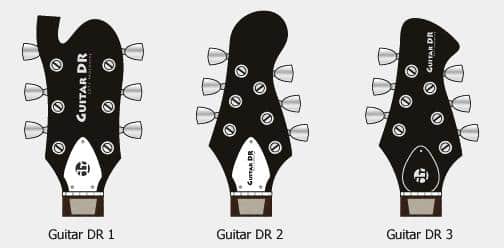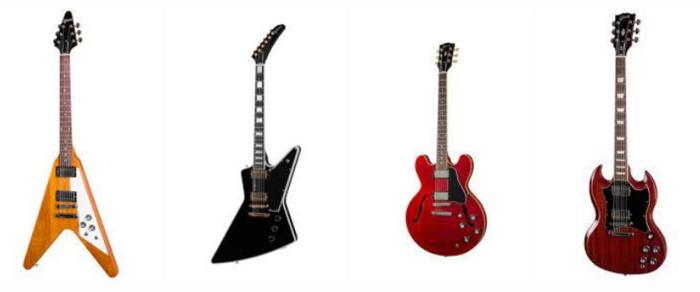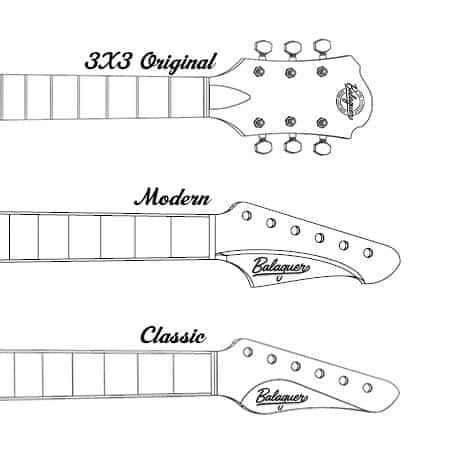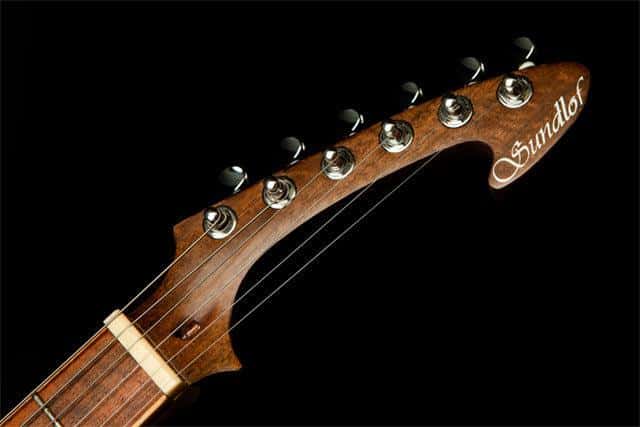You’d think the tune lies solely in your fingers, strumming strings against frets. But, what if I told you the beauty of your guitar’s melody is intimately connected to its headstock, that unassuming wingtip at the far end of the neck? You read it right; the way your guitar resonates and functions comes with a plot twist. It’s not only about the body or strings, and the secret lies in the vast universe of ‘guitar headstock shapes’.
From the inventive mind of a former engineer, I, David Garcia, transitioned into the world of lutherie, the art of making stringed instruments. The discovery of the profound impact of guitar headstock design on the sound and functionality of the instrument was a pivotal moment in my journey. A vast array of headstock shapes holds not just an aesthetic purpose, but their design and structure contribute significantly to the balance, tone, and overall ergonomics of the instrument.
Behind each curve, bevel, and intricate inlay lies a story unraveled only by understanding the science of acoustics and the infinite diversity made possible by the blend of tradition and innovation.
Intrigued? I hope so. The guitar is more than just a melodious extension of ourselves; it’s a complex and mesmerizing embodiment of physics and artistry. Gear up for an exploratory tour on the often-overshadowed topic, the ‘magic’ that lies in guitar headstock shapes. Through careful evaluation of trademark issues, iconic designs, and practical instructions on designing your own guitar’s headstock, this comprehensive overview promises to tune you into the importance of a part you might previously have overlooked. After reading this, you will be bewitched by every headstock you encounter and gain a new perspective in your musical journey. Strap in, pick in hand, and prepare to strum the song of headstock shapes!
Understanding Different Guitar Headstock Shapes
Acoustic vs Electric Headstock Shapes

Having personally seen the evolution of headstock shapes, I can attest to the significant role they play in distinguishing acoustic from electric guitars. This division is primarily the result of divergent design philosophies rather than a mere aesthetic trend. It has a deep-rooted connection to the tone, tunability, and functionality of each type of guitar.
When we delve into the world of acoustic guitar headstocks, a key feature is open tuning machine heads, often arranged in a 3+3 layout across the top. The wood that forms this headstock shape is usually an integral part of the guitar’s neck, resulting in a single continuous piece. This design sends vibrations smoothly from the guitar’s body, through the neck, into the headstock, which is crucial to the bright, resonating tone of an acoustic guitar.
Contrastingly, electric guitar headstocks often feature grouped tuning machine heads, generally in a 6-in-line layout. Many electric headstocks are constructed separately from the neck and attached later. This construction serves the tonal requirements of electric guitars, as it can reduce unwanted resonance and produce a more controlled and smooth output, typically needed for electric guitar music genres.
Moreover, the more solid, compact design of electric guitar headstocks also allows for the accommodation of string locking mechanisms. These help maintain tuning stability during extreme string bends, harmonics or tremolo usage, some quintessential elements in electric guitar playing.
Therefore, while their shapes may be mixed up or modified based on specific brands or custom designs, understanding the typical characteristics of acoustic and electric guitar headstocks can enhance your comprehension of the instrument’s design and function.
These fundamental differences between acoustic and electric headstock shapes contribute substantially to the overall theme of understanding different guitar headstock shapes. As we progress to examining a variety of headstock shapes in greater detail in the next section, keep these underlying principles concerning acoustic and electric headstocks in mind. Recognizing these will certainly assist in dissecting the various unique and iconic headstock shapes developed over the years.
Variety of Headstock Shapes

In our journey down the path of understanding different guitar headstock shapes, we now turn our attention to the extensive variety that’s out there. Each headstock shape is more than just aesthetic design, carrying with it a tale of evolution, purpose, and brand identity.
Whenever I undertake a headstock shape comparison, there tends to be an overwhelming realization of just how diversified these designs are. Their immense variety springs from many factors – from the guitar type and string method to the preference of the luthier and manufacturer design philosophy. Remember, every headstock shape has a story to tell – one that speaks volumes about the instrument’s character and lineage.
Guitars with the 3 + 3 headstock layout, like the classic Gibson Les Paul or 6 in-line design seen in Fender Stratocaster, are mainstays in popular culture. Yet, these common, iconic forms are just the tip of the iceberg. There’s an entire world populated by V-Shape, Open book, or even the eccentric reversed headstocks that defy tradition in favor of character and individuality.
Over the years, I’ve developed a deep appreciation for these unconventional designs. Their audacity broadened my understanding of what guitars could be and pushed the boundaries of my own preconceptions. In particular, the way in which each bizarre shape uniquely impacts the tone and resonance of the instrument continues to amaze me.
Hence, while it’s easy for a novice to dismiss these visual distinctions as mere superficial elements, the true connoisseur knows better. We recognize and celebrate the complexities hidden beneath the surface. Headstock variety gives each guitar its unique identity. It plays an essential role in the guitar’s functionality, affects the tone, and essentially shapes the back-story of the instrument.
To conclude, every time I encounter a new headstock shape, I treat it as an opportunity to engage in a conversation. Instead of being deterred by its strangeness, ask yourself – what does this design bring to the table? What sets it apart? And you’ll find that answering these simple questions often uncovers a narrative that fascinates and enhances your understanding of this eclectic world of guitar headstocks.
Our exploration doesn’t stop here though. In the next section, we delve deeper into the science and ergonomics of guitar headstock design. Understanding the logic behind these varied forms will further enrich our appreciation for them.
Science and Ergonomics of Guitar Headstock Design

As an engineer and musician, I’ve spent countless hours thinking about the intersection of science, ergonomics, and artistry in guitar design. One aspect of guitar design that tends to be overshadowed yet intrinsically determines character and nuance is the headstock designs. Often defined by aesthetics and brand identity, these extensions of the guitar are much more than mere embellishments. They stand as significant contributors to playability, sound, and overall player experience.
But here’s a thought: Can the shape and angle of a headstock determine a guitarist’s comfort and playing ease? You may find it intriguing, but the science behind the design of a guitar headstock is much more comprehensive and immersive than one might assume. Having spent time dissecting this hidden art, I’m excited to share some of the fascinating discoveries that have been an integral part of my engineering-musician journey.
The ergonomics of a headstock design is key to a guitarist’s playing comfort. Let’s break down this concept. The term ‘ergonomics’ refers to designing objects, systems, or processes to enhance user interaction. In the world of guitars, this implies knowing how a headstock design can affect a musician’s hand position, ease of tuning, and ultimately, their ability to churn out mellifluous tones.
I once borrowed a vintage guitar with an unusually angled headstock from a friend to play a gig. Initially, the design appeared quirky to me, but as I began to play, the ergonomics of the angled headstock turned out to be a revelation. This variation dictated the way the strings lay which resulted in a different string tension, thereby affecting playability. It then dawned on me that there is an entire universe of untapped potential in manipulating the shape and angle of the headstock!
This was the beginning of my exploration into the realm of guitar headstock design. I proceeded to understand, experiment, and create within this area, using my engineering know-how to measure tensile forces and calculate optimal angles and shapes in a guitar’s headstock. Realizing how such minute differences could have such significant impacts on my playing was both fascinating and eye-opening.
To comprehend the ergonomics of headstock design, one has to iterate, just as with any other design process. As musicians, we must understand that what suits one player may not work as well for others – the same guitar can evoke different responses based on the individual playing and his or her unique style.
In conclusion, the ergonomics of a guitar’s headstock is an exciting frontier that is often undervalued. The interplay of science and sound—where physics meets melody—proves once again that there is more to guitars than what meets the eye… or for that matter, even the ear! As one pushes the boundaries of comfort, design, and sound, it’s clear that the shape and angle of a guitar’s headstock do have a profound impact on playing comfort and ease, rendering the guitar a veritable extension of the musician’s soul.
So, as we peel back the layers and delve into the variety of headstock shapes in the next section, remember that each unique design represents a different aspect of ergonomics, playability, and the quest for the ‘perfect sound’ that each musician strives for. This vivid panorama of guitar headstock designs proves both the complexity and the beauty of this hidden art.
Trademark Issues and Guitar Headstocks

As a participating observer in this field, I have been able to witness firsthand some of the curious, and often complex, issues that can arise in the world of guitar manufacture. One of these areas I find particularly fascinating is that of headstock trademarks.
When you think about it, it’s really quite astounding how all these different manufacturers aim to create a distinctive style that sets them apart from their competitors. Especially considering that the overall design of a guitar has remained relatively unchanged since its inception. Much of a guitar’s unique identity is encapsulated in the headstock. Its design, while functional and crucial to the guitar’s proper functioning, is also a statement of branding and personality for the manufacturer.
Imagine creating an innovative headstock design, only to find it’s too similar to a patented one!
Let’s delve into the controversial realm of headstock trademark issues. In my experiences, I’ve seen how fiercely some manufacturers will fight to protect the integrity of their designs. The unassuming guitar player might be surprised to find out how deeply this protection extends right down to the headstock. Irrespective of the model and series of guitars, a pictorial impression of the headstock often suffices to identify the manufacturer.
Despite their functional commonality, the headstock designs differ significantly amongst manufacturers. Part of this is for aesthetic reasons, of course, with different shapes appealing to different tastes. However, another, less visible reason for this disparity ties back to the question of guitar manufacturers’ headstock trademarks.
From my days as a guitar shop employee to becoming a designer myself, I’ve seen a breathtaking array of lawsuits filed and cease-and-desist letters issued over apparent violations of these unique, yet vital design trademarks. I want to convey that this isn’t a trivial detail in the design of guitars; it’s a fundamental aspect of the industry’s competitive environment.
Whether it’s Fender’s patents asserting rights over its iconic Stratocaster headstock or Gibson’s lawsuits fighting to protect their designer headstocks, these legal battles have shaped the market dynamics and strategies of many companies. These battles reflect just how fiercely the manufacturers strive to maintain their distinct identity in a market crowded by common features.
But it’s not all dispute and conflict. Some manufacturers have managed to sidestep these issues by focusing on creating a unique but non-controversial design. This, too, is an art in itself, balancing the fine line of uniqueness while maintaining its credibility among the very discerning industry experts and guitar enthusiasts. When a manufacturer strikes the right balance, these creative endeavors can lead to some of the most iconic and outstanding designs we know today.
To navigate this space requires innovation, understanding, and a deep respect for what’s come before. This delicate juxtaposition between the constraint of legality and the creativity of design is an integral part of what makes the world of guitar manufacturing headstocks so incredibly entrancing.
As we gear up to explore the variety of iconic and unique guitar headstocks in our next chapter, it is essential to bear in mind the role that trademarks have played in shaping these designs. The challenges it poses can sometimes be a catalyst for truly innovative designs while at times it acts as a boundary that guards individuality.
Iconic and Unique Guitar Headstocks

As someone who played, admired and, let me tell you, scrutinized an array of guitars over the years, I’ve always found the headstock to be more than just a functional aspect of this beloved instrument. It’s a symbol, a branding statement, an art piece. It is the visual and aesthetic ambassador that hints at what can be expected from the guitar itself. That’s where the magic lies, in those unique guitar headstocks that instantaneously transport us to the soul of each brand.
Ever gazed upon a guitar and instantly recognized the brand by its headstock?
Let’s take an immersive journey into the world of iconic and unique guitar headstocks.
There are many headstock shapes that stand out, narrating their unique tale of craftsmanship and identity. To me, few examples are as instantly recognizable and striking as the PRS headstock. Its clean lines, elegantly curved like a bird in flight, make it a veritable emblem of fine craftsmanship. Yet, it’s not just about aesthetics – the PRS headstock design is practical, and with a determined purpose. Each string passes straight from the tuning peg to the nut, promoting improved tuning stability and resonance – a mark of considered design if there ever was one.
Contrast that to Gibson’s ‘open book’ headstock, a shape that has been graced by many legendary guitars such as the Les Paul and the SG. It’s a headstock that echoes the legacy of the manufacturers, their attention to detail, and their commitment to innovation. And let’s not forget the impact of that little flourish of design audacity, the Gibson logo, often elegantly inlaid with mother-of-pearl.
And how could I talk about iconic headstocks without tipping my hat to Fender? Simple yet distinctive, their design has essentially remained unchanged since the 1950s. The shape is now symbolic of the electric guitar’s golden age and Fender’s lasting influence on guitar design. There’s something reassuring about holding a Strat or a Tele, glancing up and seeing that time-honored silhouette. It’s a headstock that has become an integral part of the rock ‘n’ roll lexicon, instantly recognizable and immediately inspiring.
To understand the variety and significance of these iconic headstock shapes is to delve into the rich history of guitar making. These visual identifiers serve as a testament to the dedicated craftsmanship and innovative spirit of the luthiers who sculpted them. More than just the ‘where’ of the guitar’s strings, they are the ‘who’ and the ‘why’ – a tangible narrative of the guitar’s inception, its journey, and its purpose.
So, the next time you see an unusually shaped headstock, take a moment to think about what it represents. Is it a daring upstart like PRS, a timeless classic like Gibson, or an industry standard-bearer such as Fender? Every headstock has a story to tell about its design, origins, and what it brings to the table. All we have to do is listen.
In the next section, we’ll continue our exploration by delving into the creation of your own guitar, focusing on the role of aesthetics and design in headstock creation. It’s a space where tradition meets creativity, and personal expression shines – so stay tuned!
Creating Your Own Guitar: Headstock Design and Aesthetics

Designing your own guitar is an experience I wouldn’t trade – a rewarding process brimming with innovation, creativity, and that indescribable buzz of holding a six-stringed piece of art that echoes your persona. And the journey starts where you may not expect – the headstock. Designing the headstock is equivalent to knitting the perfect bow for your music present; it opens up the space for custom headstock design, where creativity meets functionality. No matter if you’re swinging towards a vintage vibe or pushing boundaries with something contemporary, this part of the guitar aesthetics can’t be overlooked.
So, what if you could design a guitar that not only sounds unique but looks like a work of art, starting from its headstock? Yes, you can indeed create your masterpiece, and I’ll tell you how.
It’s paramount to understand that the aesthetic appeal of a headstock is as important as its functionality. It can change your guitar’s sound and playability and leave a personal imprint that transcends time and trends. Your headstock design stands as a subtle declaration of your musical journey and your connection with the instrument.
Step one in your custom headstock design is the shape. Over the years, I’ve played, repaired, and designed countless guitars, each with a headstock shape different from the other. From the sharp and aggressive factors to fluid and effervescent forms, there’s no end to exploration. Look for inspiration anywhere and everywhere – from nature to architecture, or even everyday objects. Sketch it out, experiment, and modify until you see ‘your’ guitar taking shape.
You’d be surprised by the power of color and texture in elevating your guitar aesthetics. A glossy jet-black headstock can confer your guitar a classic air, or you could stand out with a sunburst headstock in a brilliant palette. A matte finish parallels raw authenticity, while pearl inlays or a pristine binding can bring in a touch of elegance. There’s no blueprint for this step because it is all about reflecting ‘you’ through intricate details.
Speaking of inlays, let’s delve a bit deeper into this. A trend I’ve always been fond of is the use of guitar inlay as an art form. A space meant for adding a touch of complexity and intrigue to your headstock. It can range from simple dot patterns to elaborate images and scripts that resonate with your perception of music. It becomes a part of your guitar’s identity while subtly hinting at your story without uttering a single word.
As an integral part of this process, I’d recommend seeking out a luthier or a skilled craftsman to ensure your vision is executed flawlessly. You can sketch your design, choose your materials, and discuss your inlay ideas with them. There’s an unparalleled sense of satisfaction when seeing your brainchild come to life, even more so when it’s crafted with utmost precision and care.
To wrap it up, creating a custom headstock design for your guitar isn’t just about making it visually appealing. It brings together science, ergonomics, art, and personal storytelling. Whether you’re building a brand new guitar or revitalizing an old companion, giving it a new headstock design is a beautiful way to align its voice with your distinct musical journey. Now that you’re armed with some insights, I hope you’re inspired to embark on this remarkable journey of guitar aesthetics and design.
FAQs
What are guitar headstocks?
What are some common guitar headstock shapes?
Does the shape of a guitar headstock affect the guitar’s tone?
Do guitar headstock shapes affect playability?
Conclusion
Is the guitar headstock merely a decorative accessory or a critical factor in the instrument’s overall design? You decide. As I close this guide on guitar headstock shapes, I hope I’ve managed to shed some light on the myriad intricacies involved in its design and function. We journeyed together from the basic understanding of different guitar headstock shapes, through the distinctions between acoustic and electric designs, and ventured into the delightful array of shapes in the world of guitars.
Throughout our exploration, the deeper we delved, the more we realized how guitar headstock design is so much more than an aesthetic concern. It became evident that science, ergonomics and even legal aspects shape the headstock, painting a fascinating image of interwoven knowledge and creativity. We’ve noted the uniqueness embedded not only in the iconic headstocks that define brands but also the opportunity to imprint our personalities through custom designs.
Remember, the headstock is not just the crown of your guitar, but the silent partner in your guitar’s performance, resonating the strings’ vibration and altering the instrument’s tone and sustain. So, whether you’re drawn to the classic, angular Gibson style or the smooth curve of a Fender, pay heed to the impact of their design on the overall sound.
There is no ‘right’ or ‘wrong’ when it comes to personal preference, but an informed choice enables you to align the design with your playing style and sonic vision. The challenge presented by guitar headstock design becomes an opportunity to personalize every note and chord you play, enriching your musical expression.
By now, you should be well-equipped with a galore of knowledge, ready to dissect designs and appreciate the nuances. Truth be told, pleasure often lies in the details. And who knows? Years from now, someone might be admiring the headstock shape of your guitar, seeking inspiration and admiring your contribution to the rich tapestry of guitar design.